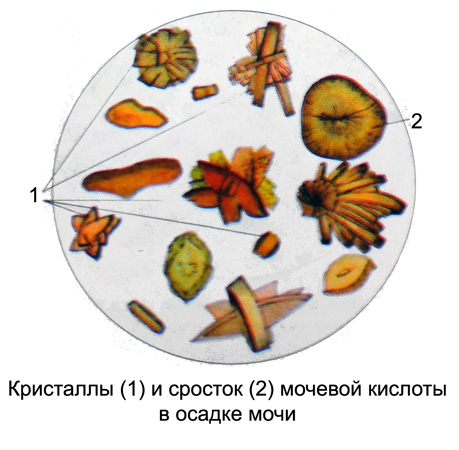Elements of acidic urine sediment – Microscopic examination of urine
Uric acid It occurs in acidic urine in the form of individual crystals and of crystalline brick-red precipitate. It settles on the bottom and on the walls of the vessel and is easily detected by the naked eye.
Microscopically uric acid crystals of various shapes and sizes.

Most often they take the form of rhombic tablets, from which crystals are formed of other shapes: whetstone, spindle and barrel, needle and hastate, stacked in bundles and bundles, as well as hexagonal plates; often crystals, Located next to and at an angle, form rosettes and Druze.
Uric acid crystals impregnated urochrome and painted in ruby red, brick red or golden-des- th color. Occasionally the crystals are colorless (eg, in leukemia). Sometimes there are uric acid crystals indefinite shape, which are identified by their yellow color and the correct shape.
Uric acid crystals are readily soluble in alkalis, It does not dissolve in hydrochloric acid and acetic acid under heating. They give characteristic reactions mureksidnuyu. To this reaction urine sediment is gently heated in a porcelain cup with a few drops of concentrated nitric acid; with a positive reaction, a yellow-red precipitate, when added in drops ammonia stained purplish red.
Amorphous urate composed of sodium urate, Potassium, Calcium, magnesium and occur in acidic urine as a fluffy pinkish precipitate. The color depends on the sediment of urate uptake urochrome. Microscopically, these salts are amorphous brown grains, which often cover the whole field of view and to consider other elements prevent sediment. In such cases, they must be dissolved.
Urata dissolve when heated and again precipitated upon cooling, They dissolve in weak alkalis and give a positive response mureksidnuyu.
The state of uric acid compounds (precipitation or stay in solution) affect the amount of urine, the degree of concentration of urine, the temperature, the degree of acidity and the presence of a protective colloid.
Precipitation of urate and uric acid wrongly considered a sign of inclination to gout. However, gout loss of these compounds does not occur in the urine, and tissue. The urine is the concentration of salt is low.
In the presence of kidney stones in the urinary sediment usually found crystals spear form, as well as bayonets, crushed stone, splices, etc.. d. Sharp angles of crystals are the cause of hematuria, caused by trauma to the urinary tract.
